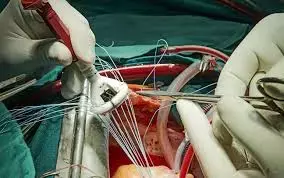- Home
- Medical news & Guidelines
- Anesthesiology
- Cardiology and CTVS
- Critical Care
- Dentistry
- Dermatology
- Diabetes and Endocrinology
- ENT
- Gastroenterology
- Medicine
- Nephrology
- Neurology
- Obstretics-Gynaecology
- Oncology
- Ophthalmology
- Orthopaedics
- Pediatrics-Neonatology
- Psychiatry
- Pulmonology
- Radiology
- Surgery
- Urology
- Laboratory Medicine
- Diet
- Nursing
- Paramedical
- Physiotherapy
- Health news
- Fact Check
- Bone Health Fact Check
- Brain Health Fact Check
- Cancer Related Fact Check
- Child Care Fact Check
- Dental and oral health fact check
- Diabetes and metabolic health fact check
- Diet and Nutrition Fact Check
- Eye and ENT Care Fact Check
- Fitness fact check
- Gut health fact check
- Heart health fact check
- Kidney health fact check
- Medical education fact check
- Men's health fact check
- Respiratory fact check
- Skin and hair care fact check
- Vaccine and Immunization fact check
- Women's health fact check
- AYUSH
- State News
- Andaman and Nicobar Islands
- Andhra Pradesh
- Arunachal Pradesh
- Assam
- Bihar
- Chandigarh
- Chattisgarh
- Dadra and Nagar Haveli
- Daman and Diu
- Delhi
- Goa
- Gujarat
- Haryana
- Himachal Pradesh
- Jammu & Kashmir
- Jharkhand
- Karnataka
- Kerala
- Ladakh
- Lakshadweep
- Madhya Pradesh
- Maharashtra
- Manipur
- Meghalaya
- Mizoram
- Nagaland
- Odisha
- Puducherry
- Punjab
- Rajasthan
- Sikkim
- Tamil Nadu
- Telangana
- Tripura
- Uttar Pradesh
- Uttrakhand
- West Bengal
- Medical Education
- Industry
Compared to non surgical treatment, Surgery exhibits long-term durability in Adult Symptomatic Lumbar Scoliosis: JAMA

According to a new study published in JAMA, long-term durability of surgical treatment for ASLS (Adult Symptomatic Lumbar Scoliosis) is promising and may aid in patient management and counseling, helping clinicians set realistic expectations and guide treatment decisions.
Long-term follow-up studies of operative and nonoperative treatment of adult symptomatic lumbar scoliosis (ASLS) are needed to assess benefits and durability. A study was done to assess the durability of treatment outcomes for operative vs nonoperative treatment of ASLS.
The Adult Symptomatic Lumbar Scoliosis 1 (ASLS-1) study was a multicenter, prospective study with randomized and observational cohorts designed to assess operative vs nonoperative ASLS treatment. Operative and nonoperative patients were compared using as-treated analysis of combined randomized and observational cohorts. Patients with ASLS aged 40 to 80 years were enrolled at 9 centers in North America. Data were analyzed from November 2023 to July 2024.
Primary outcomes measures were the Oswestry Disability Index (ODI) and Scoliosis Research Society 22 (SRS-22) at 2-, 5-, and 8-year follow-up. Results The 286 enrolled patients (104 in the nonoperative group: median [IQR] age, 61.9 [54.4-68.8] years; 97 female [93%]; 182 in the operative group: median [IQR] age, 60.2 [53.5-66.6] years; 161 female [88%]) had follow-up rates at 2, 5, and 8 years of 90% (256 of 286), 70% (199 of 286), and 72% (205 of 286), respectively.
At 2 years, compared with those in the nonoperative group, patients in the operative group had better ODI (mean difference = −12.98; 95% CI, −16.08 to −9.88; P < .001) and SRS-22 (mean difference = 0.57; 95% CI, 0.45-0.70; P < .001) scores, with mean differences exceeding the minimal detectable measurement difference (MDMD) for ODI (7) and SRS-22 (0.4). Mean differences at 5 years (ODI = −11.25; 95% CI, −15.20 to 7.31; P <.001; SRS-22 = 0.58; 95% CI, 0.44-0.72; P < .001) and 8 years (ODI = −14.29; 95% CI, −17.81 to −10.78; P <.001; SRS-22 = 0.74; 95% CI, 0.57-0.90; P < .001) remained as favorable as at 2 years without evidence of degradation.
The treatment-related serious adverse event (SAE) incidence rates for operative patients at 2, 2 to 5, and 5 to 8 years were 22.24, 9.08, and 8.02 per 100 person-years, respectively. At 8 years, operative patients with 1 treatment-related SAE still had significant improvement, with mean treatment differences that exceeded MDMD (ODI = −9.49; 95% CI, −14.23 to −4.74; P < .001; SRS-22 = 0.62; 95% CI, 0.41-0.84; P < .001). Results of this nonrandomized clinical trial reveal that, on average, operative treatment for ASLS provided significantly greater clinical improvement than nonoperative treatment at 2-, 5- and 8-year follow-up, with no evidence of deterioration. Operative patients with a treatment-related SAE still maintained greater improvement than nonoperative patients. These findings suggest long-term durability of surgical treatment for ASLS and may prove useful for patient management and counseling.
Reference:
Smith JS, Kelly MP, Yanik EL, et al. Operative vs Nonoperative Treatment for Adult Symptomatic Lumbar Scoliosis at 8-Year Follow-Up: A Nonrandomized Clinical Trial. JAMA Surg. Published online April 02, 2025. doi:10.1001/jamasurg.2025.0496
Dr. Shravani Dali has completed her BDS from Pravara institute of medical sciences, loni. Following which she extensively worked in the healthcare sector for 2+ years. She has been actively involved in writing blogs in field of health and wellness. Currently she is pursuing her Masters of public health-health administration from Tata institute of social sciences. She can be contacted at editorial@medicaldialogues.in.
Dr Kamal Kant Kohli-MBBS, DTCD- a chest specialist with more than 30 years of practice and a flair for writing clinical articles, Dr Kamal Kant Kohli joined Medical Dialogues as a Chief Editor of Medical News. Besides writing articles, as an editor, he proofreads and verifies all the medical content published on Medical Dialogues including those coming from journals, studies,medical conferences,guidelines etc. Email: drkohli@medicaldialogues.in. Contact no. 011-43720751


